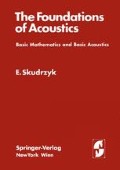Abstract
We must distinguish between dimensional equations that are valid in all self consistent systems of units and equations that give the numerical values only in a specified system of units. A dimensional equation, for instance, is
This equation holds regardless of what the units are. In contrast, the equation
where u represents a voltage and i a current, holds only in the system of units for which the numerical value 23 has been specified. Strictly speaking, this equation is incorrect in the form written because 23 is a number of zero dimension; and volts as given by the left-hand side, can never be amperes, as given by the right-hand side. To draw attention to this fact, 23 is underlined to indicate that it is not just a number, but also has a dimension. It is poor practice to omit dimensional symbols, because a dimensional check is always the first step in tracing computational errors. The equations in this book, therefore, refer to dimensional magnitudes almost without exception, and they hold for every coherent system of units.
Access this chapter
Tax calculation will be finalised at checkout
Purchases are for personal use only
Preview
Unable to display preview. Download preview PDF.
Reference
The American Society of Mechanical Engineers, “Letter Symbols for Acoustics”, New York, N. Y. 1959.
American Standards Association, New York, N. Y. 1960: Incorporated, “Acoustical Terminology”; C 61. 1–1961 Quantities and Units Used in Electricity, 1966.
Bodea, E.: Giorgis rationales MKS-Maßsystem mit Dimensionskohärenz für Mechanik, Elektromagnetik, Thermik, fundiert auf Kalantaroff’s (LTQ)-System, 2. Aufl. Basel: Birkhäuser. 1949.
Bridgeman, P. W.: Theorie der physikalischen Dimensionen. Leipzig, Berlin: Teubner. 1932; Dimensional analysis. New Haven and London: Yale University Press. January.
Cornelius, P.: The rationalized Giorgi system with absolute volt and ampere as applied in electrical engineering. Philips techn. Rev. 10 (1948) 79–86.
Cornelius, P., Hamaker, H. C.: The rationalized Giorgi system and its consequences.Philips Res. Rep. 4 (1949) 123–142.
Cowan, E. W.: Basic electricity magnetism. New York, N. Y.: Academic Press. 1968.
Curtis, H. L.: Electrical measurements. New York, N. Y.: McGraw-Hill. 1937.
Dunconson, W. E.: The dimensions of physical quantities. Proc. Physic. Soc. London 53 (1941) 432–448.
Golding, E. W.: Electrical measurements and measuring instruments (Kap. II). London: Pitman and Sons. 1933.
Groot, W. De: Die Entstehungsgeschichte des Giorgi-Systems der elektrischen Einheiten. Philips techn. Rdsch. 10 (1948/49) 54–60.
Guggenheim, E. A.: Units and dimensions. Philos. Mag. 33 (1942) 479–496.
Halsey, R. J.: The rationalised M.K.S. system of electrical units. Post Office Electr. Engr. J. 46, 4, 187–190.
Hecht, H.: Betrachtungen zum physikalischen Maßsystem. Göttingen: Wissenschaftl. Verlag Musterschmidt. 1951.
Jackson, L.: Classical electrodynamics. New York, N. Y.: Wiley. 1962.
Knetssler, L.: Über das Meter-Kilogramm-Sekunden-System (System Giorgi). E und M 54(1936) 1–2.
Oberdorfer, G.: Das natürliche Maßsystem. Wien: Springer. 1949.
Sralicky, M.: Die neuen elektrischen absoluten Maßeinheiten. Siemens Austria Z. 1 (1949) 25–27.
Verheulen, R.: Normung akustischer Größen. Philips techn. Rdsch. 5 (1940) 250–251;
Verheulen, R.: Dimensional analysis, units and rationalisation. Philips Res. Rep. 7 (1952) 432–441.
Wallot, J.: Größengleichungen und Zahlenwertgleichungen. E.T.Z. 64 (1943) 13–16;
Wallot, J.: Elektrische Maßsysteme. E.T.Z. 64 (1943) 299–303.
Williams, H. P.: Electrical units and the MKS System. Electr. Communic. 23 (1946) 96–105.
United States Department of Commerce: Stans, M. H., ASTIN, A. V.: The English and metric systems of measurement (Special Publication 304 A, issued 1968, revised 1969), available from the Superintendent of Documents, U. S. Government Printing Office, Washington, D. C. 20402.
New Values for the Physical Constants,Recommended by NAS-NRC, NBS Technical News Bulletin, October 1963, also NBS Technical News Bulletin, May 1965 (For sale by the uperintendent of Documents, U. S. Government Printing Office, Washington, D. C. 20402).
International Organization for Standardization,available from the USA. Standards Institute, 10 East 40th St., New York, N. Y.:R 31-Part I-1965 Basic quantities and units of the SI.
International Organization for Standardization,available from the USA. Standards Institute, 10 East 40th St., New York, N. Y.: R 31-Part II-1958 Quantities and units of periodic and related phenomena.
International Organization for Standardization,available from the USA. Standards Institute, 10 East 40th St., New York, N. Y.:R 31-Part III-1960 Quantities and units of mechanics (Z 10.3–1948, [R 1953]).
International Organization for Standardization,available from the USA. Standards Institute, 10 East 40th St., New York, N. Y.:R 31-Part IV-1960 Quantities and units of heat (Y 10.4–1957).
International Organization for Standardization,available from the USA. Standards Institute, 10 East 40th St., New York, N. Y.:R 31-Part V-1965 Quan tities and units of electricity and magnetism.
International Organization for Standardization,available from the USA. Standards Institute, 10 East 40th St., New York, N. Y.:R 31-Part VII-1965 Quantities and units of acoustics.
International Organization for Standardization,available from the USA. Standards Institute, 10 East 40th St., New York, N. Y.:R 31-Part XI-1961 Mathematical signs and symbols for use in the physical sciences and technology.
International Organization for Standardization,available from the USA. Standards Institute, 10 East 40th St., New York, N. Y.:Y 10.19–1967 Letter symbols for units in electrical • science and electrical engineering [(I.E.E.E. No. 260), September 1968].
Author information
Authors and Affiliations
Rights and permissions
Copyright information
© 1971 Springer-Verlag/Wien
About this chapter
Cite this chapter
Skudrzyk, E. (1971). Equations and Units. In: The Foundations of Acoustics. Springer, Vienna. https://doi.org/10.1007/978-3-7091-8255-0_2
Download citation
DOI: https://doi.org/10.1007/978-3-7091-8255-0_2
Publisher Name: Springer, Vienna
Print ISBN: 978-3-7091-8257-4
Online ISBN: 978-3-7091-8255-0
eBook Packages: Springer Book Archive

